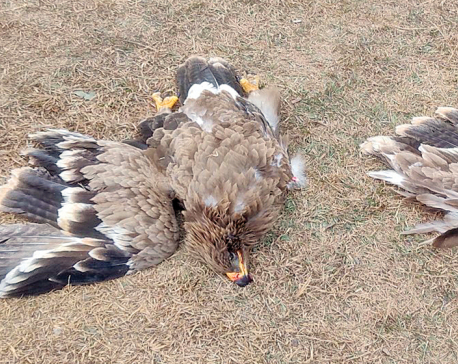
OR
Foxes and birds pose risk to aircraft at PRIA
Published On: February 14, 2023 09:00 AM NPT By: Santosh Pokharel
_20220508065427.jpg)
POKHARA, Feb 14: Bijayapur River is located in the east of the Pokhara Regional International Airport (PRIA). To the south lies the Seti River. The Bijaypur River is closer to the runway. As soon as the aircraft, which is in the process of landing, crosses the river, it reaches the runway.
Because of unchecked dumping, both these rivers that flow near the airport are smelly most of the time. The Bijayapur River is more polluted than the Seti River. Dead cattle, dogs, cats, chickens and the waste left after slaughtering animals are thrown into the river. As a result, the river area has become smelly and because of that, birds are attracted to that area. The airport has said that the birds which come to feed the decaying animal corpses have become a 'challenge' for the airport.
The problem intensifies when the water in the river is low as more birds are attracted due to the silt. According to the airport chief Bikram Gautam, the birds are attracted due to the silt that is randomly thrown in the river, which has affected the regular flights during landings and takeoff at the airport. A few days ago, a bird collided with an aircraft while landing, said Gautam.
He said that flocks of birds used to fly in front of the runway of the airport. Throwing garbage in the river has increased the problem. Although the metropolis buried the landfill site saying that there was a risk of birds due to the garbage, the waste being dumped directly into the rivers posing serious threat to aircraft security, said Gautam, adding, "There are more birds in the Bijaypur River. Flocks of birds fly away when an aircraft is about to land.”
Earlier, the landfill site of Pokhara-14 Bachchebuduwa, which was used to manage waste by the Pokhara metropolis, was relocated after the airport came into operation.
Bodh Raj Karki, chairman of the Concern Committee for Landfill Site Affected People of Pokhara-14, says that apart from the risks caused by garbage, there is also the risk of foxes due to the bushes in the airport area at night time.
"There are birds in the airport area during the day and foxes at night. The sound of foxes can be heard throughout the night near our settlement,” said Karki. He estimates that there are at least 100 foxes on the airport premises.
According to Karki, the Civil Aviation Authority of Nepal (CAN) was also informed that there was a problem of foxes in the area before the airport came into operation. He said that it was suggested to clear the bushes to prevent the foxes from hiding, but there was no response.
“The foxes that hide in the bushes at the sound of the aircraft in the afternoon come out to the open square of the airport in the evening. As there are no night flights so far, foxes start howling in the evening," Karki said, adding, "Foxes howl in the airport area throughout the night. We are afraid that when the fox runs towards the runway, it will collide with the aircraft.”
According to Kakri, more garbage is thrown towards Bijaypur and in the Deurali area. “Apart from that, there is still a habitat of vultures in that area,” he said.
Hemanta Dhakal, secretary of the Pokhara Bird Society, also says that foxes hiding in the bushes in the airport area are just as dangerous as birds. Dhakal, who is also a local resident living near the airport, says, "Foxes walk around the canals in the airport area all night long. There are foxes inside the airport. There is fear of birds during the day time and foxes at night.”
There are also colonies of bats. A colony of bats is located in one particular tree. Apart from that, the carcass of dead animals that flow in the Bijaypur and Seti rivers is the only food of vultures, according to Dhakal. He said that even though the airport has been built and put into operation, there is not much initiative to reduce the risk.
“Government agencies only paid attention to building and running the airport, but did not pay attention to reducing the risk. The problems of birds and foxes will increase after garbage flows into the river," he said.
You May Like This

Birds pose a serious risk to flights in the skies of Pokhara
POKHARA, Feb 22: His real name is Ishwar KC, but on social media, his name is 'Ishu Bro'. A video... Read More...
-1200x560_20221214140537.jpg)
Paragliding to be allowed in Pokhara skies three hours a day
POKHARA, Dec 14: After the Pokhara Regional International Airport (PRIA) comes into operation from January 1, it is not yet... Read More...

Brazil's new coach sees risk of not qualifying for World Cup
RIO DE JANEIRO, June 21: On his first day in the job, new Brazil coach Adenor Leonardo Bacchi was already... Read More...



Just In
- World Malaria Day: Foreign returnees more susceptible to the vector-borne disease
- MoEST seeks EC’s help in identifying teachers linked to political parties
- 70 community and national forests affected by fire in Parbat till Wednesday
- NEPSE loses 3.24 points, while daily turnover inclines to Rs 2.36 billion
- Pak Embassy awards scholarships to 180 Nepali students
- President Paudel approves mobilization of army personnel for by-elections security
- Bhajang and Ilam by-elections: 69 polling stations classified as ‘highly sensitive’
- Karnali CM Kandel secures vote of confidence















Leave A Comment